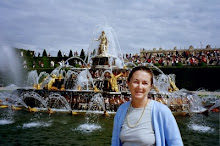The ancient city of Edinburgh, Scotland was built upon an extinct volcano. The skyline is dominated by the Royal Mile which begins at Holyroodhouse Palace and rises a mile or so to terminate at Edinburgh Castle. After our week hiking St. Cuthbert's Way, my friends and I removed to a small hotel in a lovely village on the Firth of Forth and made a day trip just to visit Edinburgh Castle.
Here are some photographs from that visit.
 |
| The mile-long street between the Castle and Holyroodhouse Palace is the Royal Mile. The upper end of the street is Castlehill. |
 |
| This photo was taken after we'd left the Castle - in the rain. Hence the overcast appearance. Typical UK weather: sun, clouds, rain, all in just one afternoon. |
 |
| This is the Esplanade - large parade ground outside the Castle gates. In August is the famous Military Tattoo, which we'd just missed by a few weeks. |
 |
| At the (19th century) entrance are statues of Scotland's great heroes, Robert the Bruce on the left and William Wallace on the right. The statues, I'm told, were made in the 1920s. |
 |
| Far below the Castle and to the North, in the so-called New Town (really new in the 18th century), is Princes Street, now a major shopping street in the city. |
 |
| Between the Castle and Princes Street lies Princes Street Gardens, where once was a lake. Beyond in the far distance is the "Kingdom of Fife" and between there and Edinburgh is Firth of Forth. A firth, I'm told, is a river estuary. I hope that's true. |
 |
| This very high arch connects the Scottish War Memorial (left) with the Royal Palace (right). |
 |
| This palace was the residence of the Stewart kings and queens in the 15th & 16th centuries, the birthplace of King James VI in 1566 (later James I of England), and the home of the Scottish crown jewels. |
 |
| The facade of the Royal Palace. Together it forms a great square, with the Great Hall, the Scottish United Services Museum, and the Scottish War Memorial. |
 |
| Inside the Great Hall, a beautiful 15th century hall lined with medieval weapons, we found this quartet wearing period clothes and playing period music on period instruments. This happens only once monthly; we were very lucky. |
 |
| The walls of the Great Hall are lined with weapons like these swords and claymores, also with shields, pistols, mortars, pikes, axes, and some several suits of armor. Also with the coats of arms of many clans. |
 |
| These are the steps into the Scottish War Memorial, where no photographs were allowed. |
 |
| St. Margaret was a queen of Scotland in the 12th century, known for her virtue, goodness, and generosity. She's a patron saint of Scotland (which seems to have more than one), and this window is in the very tiny St. Margaret's Chapel |
 |
| The building with the zig-zag roof is now a restaurant, and to the right of it is the famous One O'Clock Gun - - not 12:00 or any other hour but 1:00 pm to inform pre-wristwatch citizens of the hour. Scots have a reputation for frugality: one gun shot is cheaper and easier than booming away 12 times. |
 |
| The Castle is very hilly and rocky; many of the connecting paths are steps and many are curved, like this one. |
 |
| Inside the Casemates is this section recreating where prisoners of war lived - from the Seven Years War up through the Napoleonic Wars and the War of 1812. Note: During the American Revolution, colonial captives were not well treated because they weren't considered soldiers but rather traitors and held as common criminals. |
 |
| Barbara is trying to capture what an individual person's surroundings were. |
 |
| Prisoners of war were allotted pease, bread, cheese, and [not shown here] 2 pints of ale daily. |
 |
| Uniform of a French Officer - - contrast this colorful and elegant coat with contemporary camouflage uniforms. |
 |
| Emperor Napoleon's regiments carried at their head an imperial eagle, with the regiment's number at the base. The design was supposed to be Roman. This eagle was taken during the Battle of Waterloo, June 18, 1815, by a Sargeant in the Royal Scots' Greys, a cavalry unit. |
 |
| The Standard of the French Imperial 45th Infantry Regiment whose eagle is just above. |
 |
| I very much liked reading this description of the battle scene when the Imperial Eagle was captured by the Scots Grey. |
 |
We left the Castle by passing through this, the Portcullis Gate, and into the Royal Mile.
|
 |
| Night is coming; Castle is closing; we'll walk down the Royal Mile, find some place for dinner, and take the train back to the little village of Aberdour. What a nice day it was. |

























No comments:
Post a Comment